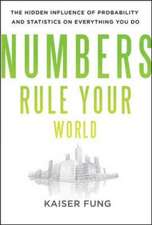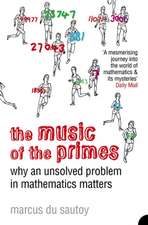A Short History of Mathematical Population Dynamics
Autor Nicolas Bacaëren Limba Engleză Paperback – 25 noi 2010
<p>This book traces the history of population dynamics---a theoretical subject closely connected to genetics, ecology, epidemiology and demography---where mathematics has brought significant insights. It presents an overview of the genesis of several important themes: exponential growth, from Euler and Malthus to the Chinese one-child policy; the development of stochastic models, from Mendel's laws and the question of extinction of family names to percolation theory for the spread of epidemics, and chaotic populations, where determinism and randomness intertwine.</p>
<p>The reader of this book will see, from a different perspective, the problems that scientists face when governments ask for reliable predictions to help control epidemics (AIDS, SARS, swine flu), manage renewable resources (fishing quotas, spread of genetically modified organisms) or anticipate demographic evolutions such as aging.</p>
Preț: 345.25 lei
Nou
Puncte Express: 518
Preț estimativ în valută:
66.10€ • 67.81$ • 55.65£
66.10€ • 67.81$ • 55.65£
Carte tipărită la comandă
Livrare economică 27 februarie-13 martie
Preluare comenzi: 021 569.72.76
Specificații
ISBN-13: 9780857291141
ISBN-10: 0857291149
Pagini: 160
Ilustrații: X, 160 p. 60 illus.
Dimensiuni: 155 x 235 x 9 mm
Greutate: 0.25 kg
Ediția:2011
Editura: SPRINGER LONDON
Colecția Springer
Locul publicării:London, United Kingdom
ISBN-10: 0857291149
Pagini: 160
Ilustrații: X, 160 p. 60 illus.
Dimensiuni: 155 x 235 x 9 mm
Greutate: 0.25 kg
Ediția:2011
Editura: SPRINGER LONDON
Colecția Springer
Locul publicării:London, United Kingdom
Public țintă
GraduateCuprins
The Fibonacci sequence (1202).- Halley’s life table (1693).- Euler and the geometric growth of populations (1748–1761).- Daniel Bernoulli, d’Alembert and the inoculation of smallpox (1760).- Malthus and the obstacles to geometric growth (1798).- Verhulst and the logistic equation (1838).- Bienaymé, Cournot and the extinction of family names (1845–1847).- Mendel and heredity (1865).- Galton, Watson and the extinction problem (1873–1875).- Lotka and stable population theory (1907–1911).- The Hardy–Weinberg law (1908).- Ross and malaria (1911).- Lotka, Volterra and the predator–prey system (1920–1926).- Fisher and natural selection (1922).- Yule and evolution (1924).- McKendrick and Kermack on epidemic modelling (1926–1927).- Haldane and mutations (1927).- Erlang and Steffensen on the extinction problem (1929–1933).- Wright and random genetic drift (1931).- The diffusion of genes (1937).- 21 The Leslie matrix (1945).- 22 Percolation and epidemics (1957).- 23 Game theory and evolution (1973).- 24 Chaotic populations (1974).- 25 China’s one-child policy (1980).- 26 Some contemporary problems.
Recenzii
From the reviews:
"Bacaër has done an excellent job of selecting an interesting and coherent set of mathematical problems in population dynamics, which has resulted in an accessible volume of just the right size. The book should be equally at home in an academic library, on a teacher’s or professor’s resource shelves, or even in the bathroom pile at home. To anyone with an interest in mathematics and the dynamics and implications of population growth, I recommend this excellent and delightful book" (SIAM, December 2011)
“This brief book is largely a translation of the French 2008 work with some small changes. Bacaer (IRD, Institut de recherche pour le developpement, France) provides 26 stories about mathematical population models, including biographical information about their creators or popularizers … . The mathematics goes down smoothly with the story. This would be an ideal book for an undergraduate seminar. For the teacher, it is also an ideal source for short tales that will enliven lectures. Summing Up: Highly recommended. Upper-division undergraduates through professionals.” (P. Cull, Choice, Vol. 48 (9), May, 2011)
“The book contains a wonderful collection of topics that illustrate applications of mathematics to solving various problems in population biology and population growth, demography and epidemiology. … models considered have been thoughtfully investigated and widely used in applications, and their numerous modifications have been suggested and studied. … model construction are explained in a way that is clear to those with little mathematical preparation, but still interesting to mathematicians. … equations are explained in detail, which makes the discussion understandable for a general audience.” (Natali Hritonenko, Mathematical Reviews, Issue 2011)
“Nicolas Bacaër has written a charming book in which he invites us into his study for an entertaining tour of historical problems inpopulation dynamics and the mathematicians who worked on them. … the chapters would be suitable for bright high school students or teachers in search of interesting mathematical problems with real relevance to humankind. … The book should be equally at home in an academic library, on a teacher’s or professor’s resource shelves … . I recommend this excellent and delightful book.” (Rebecca Tyson, SIAM Review, Vol. 53 (4), 2011)
"Bacaër has done an excellent job of selecting an interesting and coherent set of mathematical problems in population dynamics, which has resulted in an accessible volume of just the right size. The book should be equally at home in an academic library, on a teacher’s or professor’s resource shelves, or even in the bathroom pile at home. To anyone with an interest in mathematics and the dynamics and implications of population growth, I recommend this excellent and delightful book" (SIAM, December 2011)
“This brief book is largely a translation of the French 2008 work with some small changes. Bacaer (IRD, Institut de recherche pour le developpement, France) provides 26 stories about mathematical population models, including biographical information about their creators or popularizers … . The mathematics goes down smoothly with the story. This would be an ideal book for an undergraduate seminar. For the teacher, it is also an ideal source for short tales that will enliven lectures. Summing Up: Highly recommended. Upper-division undergraduates through professionals.” (P. Cull, Choice, Vol. 48 (9), May, 2011)
“The book contains a wonderful collection of topics that illustrate applications of mathematics to solving various problems in population biology and population growth, demography and epidemiology. … models considered have been thoughtfully investigated and widely used in applications, and their numerous modifications have been suggested and studied. … model construction are explained in a way that is clear to those with little mathematical preparation, but still interesting to mathematicians. … equations are explained in detail, which makes the discussion understandable for a general audience.” (Natali Hritonenko, Mathematical Reviews, Issue 2011)
“Nicolas Bacaër has written a charming book in which he invites us into his study for an entertaining tour of historical problems inpopulation dynamics and the mathematicians who worked on them. … the chapters would be suitable for bright high school students or teachers in search of interesting mathematical problems with real relevance to humankind. … The book should be equally at home in an academic library, on a teacher’s or professor’s resource shelves … . I recommend this excellent and delightful book.” (Rebecca Tyson, SIAM Review, Vol. 53 (4), 2011)
Textul de pe ultima copertă
<p>As Eugene Wigner stressed, mathematics has proven unreasonably effective in the physical sciences and their technological applications. The role of mathematics in the biological, medical and social sciences has been much more modest but has recently grown thanks to the simulation capacity offered by modern computers.</p>
<p>This book traces the history of population dynamics---a theoretical subject closely connected to genetics, ecology, epidemiology and demography---where mathematics has brought significant insights. It presents an overview of the genesis of several important themes: exponential growth, from Euler and Malthus to the Chinese one-child policy; the development of stochastic models, from Mendel's laws and the question of extinction of family names to percolation theory for the spread of epidemics, and chaotic populations, where determinism and randomness intertwine.</p>
<p>The reader of this book will see, from a different perspective, the problems that scientists face when governments ask for reliable predictions to help control epidemics (AIDS, SARS, swine flu), manage renewable resources (fishing quotas, spread of genetically modified organisms) or anticipate demographic evolutions such as aging.</p>
<p>This book traces the history of population dynamics---a theoretical subject closely connected to genetics, ecology, epidemiology and demography---where mathematics has brought significant insights. It presents an overview of the genesis of several important themes: exponential growth, from Euler and Malthus to the Chinese one-child policy; the development of stochastic models, from Mendel's laws and the question of extinction of family names to percolation theory for the spread of epidemics, and chaotic populations, where determinism and randomness intertwine.</p>
<p>The reader of this book will see, from a different perspective, the problems that scientists face when governments ask for reliable predictions to help control epidemics (AIDS, SARS, swine flu), manage renewable resources (fishing quotas, spread of genetically modified organisms) or anticipate demographic evolutions such as aging.</p>
Caracteristici
Presents interesting historical background information as well as mathematical analysis of select classical mathematical models in population biology Provides complementary reading for undergraduates and postgraduates studying mathematical biology Details the lives of mathematicians who have made major contributions to the field Mathematical details are provided in clear-cut boxes, enabling readers to opt for a 'lighter' read over the more technical option Includes supplementary material: sn.pub/extras














